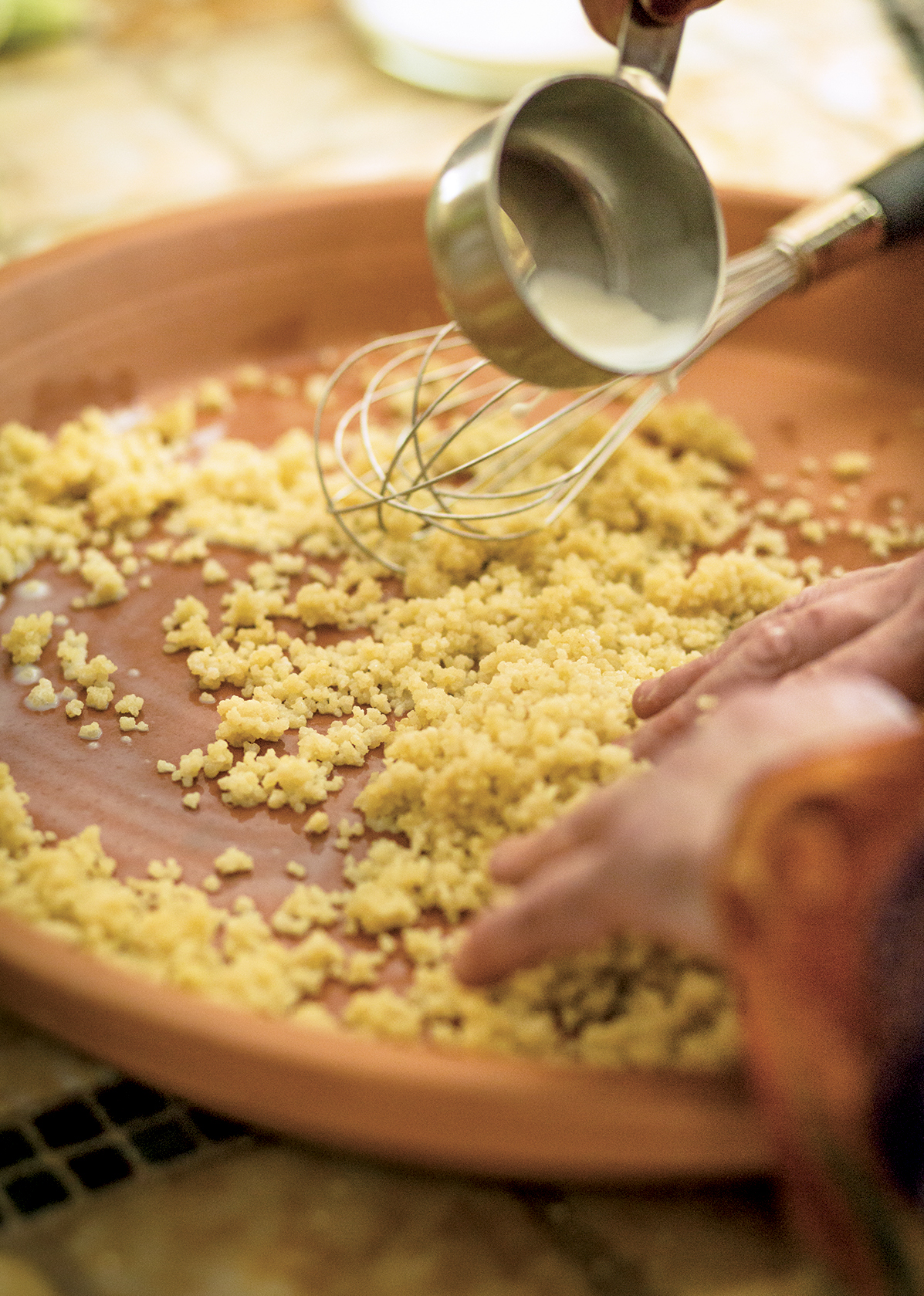Steamed Couscous
Serves 8 to 10
 The steamed couscous can be held several hours before serving.
The steamed couscous can be held several hours before serving.
“If I could teach people one thing, it’s to know the magic of steamed couscous,” Paula told me. “If I could teach them two, it would be to roll their own,” she added (recipe follows, here). Most of us cook couscous like rice, simmering it in water or broth. But steaming it triples its volume, rendering it lighter, fluffier, and, Paula insists, easier to digest.
In Morocco, couscous is typically steamed three to seven times before serving. What might be the most magical part of this kitchen ritual is that the couscous does not swell as it steams but rather when it is resting on a wide platter between steamings, after it has been raked with milk or water. Nothing but a slow hydration process, raking works best on a large platter made of unglazed clay, a material that helps absorb moisture. Paula suggests using an Italian-made clay pot liner, about 18 inches (45 cm) in diameter, sold at many garden stores. Any wide plate will do, however. Traditionally couscous is raked with water, but from a Moroccan friend Paula discovered that raking it with milk “really makes it ‘sing.’”
Hand-Rolled Couscous (here), or 1½ pounds (675 g) 100 percent semolina instant couscous
2 tablespoons smen (here) or unsalted butter, preferably clarified, cut into ¼-inch (6-mm) cubes and at room temperature
1½ cups (360 ml) whole milk, at room temperature
½ cup (120 ml) room temperature water, plus ¼ to ½ cup (60 to 120 ml) if using hand-rolled couscous
Pour water into the bottom of couscousière or into a large pot fitted with a flat-bottomed steamer basket to within 1 to 2 inches (2.5 to 5 cm) of the base of the top tier of the couscousière or the steamer basket, then remove the top tier or basket. Bring the water to a boil over high heat. (Paula also suggests tossing a penny into the pot; when it stops clicking, it’s time to add more water.)
If using instant couscous, put the couscous in a large bowl, add 2 cups (480 ml) water, stir, and let stand for 1 minute. Drain and transfer the moistened couscous to a wide platter, preferably an unglazed earthenware platter 18 inches (45 cm) in diameter. With dampened hands, lift up the moistened grains, rub them gently between your palms, and let them fall back onto the platter to break up any lumps. Repeat once or twice as needed to remove any remaining lumps. If using hand-rolled couscous, it is ready for steaming once it has been shaped on the earthenware plate.
Whether using homemade or store-bought instant couscous, follow these steps to steam it to plump perfection.
FIRST STEAMING AND RAKING
Line the inside of the top tier of the couscousière or the steamer basket with muslin or cheesecloth, extending the four corners of the cloth over the sides of the steamer, being careful not to let it get near any flame. Fit the steamer basket snugly over the boiling water. If you see steam escaping along the sides, seal the seam with a long strip of foil or a dampened kitchen towel.
Add the couscous to the cloth-lined couscousière tier or steamer basket and steam, keeping the water at a steady boil, uncovered, for 20 minutes.
Gather up the cheesecloth, then dump the couscous onto the platter, shaking out the cheesecloth. Using a wire whisk, spread out the grains. Scatter the cubes of smen over the couscous and, using the whisk, gently toss the hot grains to coat them evenly with the smen. Working in batches of several tablespoons at a time, sprinkle the milk over the couscous and, using the whisk, your fingers, or a combination, rake the milk into the grains, lifting and stirring them gently to break up any lumps after each addition. When all of the milk has been incorporated, smooth out the grains into a thin layer and let stand for 10 minutes. The couscous will begin to swell.
SECOND STEAMING AND RAKING
Return the cheesecloth to the couscousière tier or steamer basket. Add the couscous and steam at a steady boil, uncovered, for another 20 minutes.
Regather the cheesecloth, return the couscous to the platter, and spread out again with the whisk. Working in batches of a few tablespoons at a time, sprinkle the ½ cup (120 ml) water over the couscous and, using the whisk, your fingers, or a combination, rake the water into the grains, lifting and stirring them gently to break up any lumps after each addition. When all of the water has been incorporated, smooth out the grains into a thin layer and let stand for another 10 minutes. The couscous will continue to swell.
THIRD STEAMING (FOR HAND-ROLLED COUSCOUS ONLY)
If using hand-rolled couscous, repeat the steps for the second steaming and raking with the ¼ to ½ cup (60 to 120 ml) water, adding as much as needed for the grains to plump nicely. If the grains still appear tight, you can steam and rake hand-rolled couscous up to four more times, or for a total of seven times.
When the couscous has plumped to your satisfaction, serve at once. Or if you are preparing the couscous in advance, cover the grains loosely with a damp kitchen towel and remove the couscousière or pot from the heat, reserving the water in the bottom. The couscous will hold for several hours. To serve the couscous on its own, return the water in the bottom of the couscousière or pot to a boil and steam the couscous for 10 more minutes before serving. To incorporate the couscous into a recipe such as Berber Couscous for Spring (here), follow the instructions in the recipe for the final steaming.

